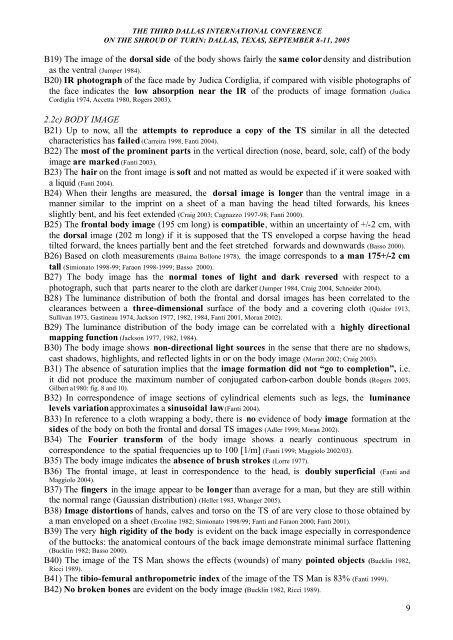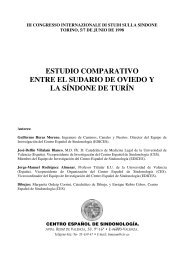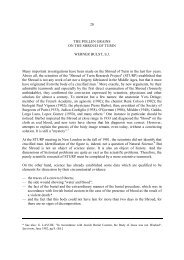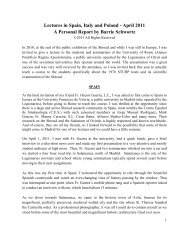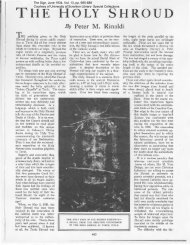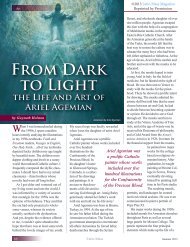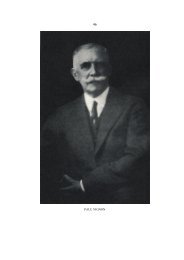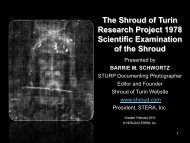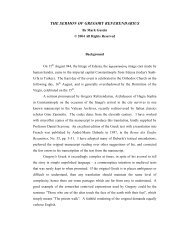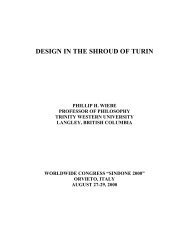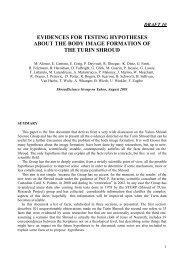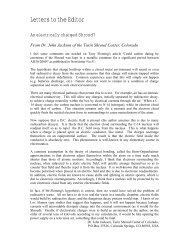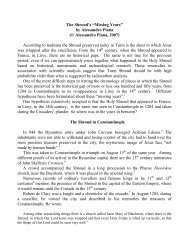Evidences for Testing Hypotheses about the Body Image Formation ...
Evidences for Testing Hypotheses about the Body Image Formation ...
Evidences for Testing Hypotheses about the Body Image Formation ...
Create successful ePaper yourself
Turn your PDF publications into a flip-book with our unique Google optimized e-Paper software.
THE THIRD DALLAS INTERNATIONAL CONFERENCEON THE SHROUD OF TURIN: DALLAS, TEXAS, SEPTEMBER 8-11, 2005B19) The image of <strong>the</strong> dorsal side of <strong>the</strong> body shows fairly <strong>the</strong> same color density and distributionas <strong>the</strong> ventral (Jumper 1984).B20) IR photograph of <strong>the</strong> face made by Judica Cordiglia, if compared with visible photographs of<strong>the</strong> face indicates <strong>the</strong> low absorption near <strong>the</strong> IR of <strong>the</strong> products of image <strong>for</strong>mation (JudicaCordiglia 1974, Accetta 1980, Rogers 2003).2.2c) BODY IMAGEB21) Up to now, all <strong>the</strong> attempts to reproduce a copy of <strong>the</strong> TS similar in all <strong>the</strong> detectedcharacteristics has failed (Carreira 1998, Fanti 2004).B22) The most of <strong>the</strong> prominent parts in <strong>the</strong> vertical direction (nose, beard, sole, calf) of <strong>the</strong> bodyimage are marked (Fanti 2003).B23) The hair on <strong>the</strong> front image is soft and not matted as would be expected if it were soaked witha liquid (Fanti 2004).B24) When <strong>the</strong>ir lengths are measured, <strong>the</strong> dorsal image is longer than <strong>the</strong> ventral image in amanner similar to <strong>the</strong> imprint on a sheet of a man having <strong>the</strong> head tilted <strong>for</strong>wards, his kneesslightly bent, and his feet extended (Craig 2003; Cagnazzo 1997-98; Fanti 2000).B25) The frontal body image (195 cm long) is compatible, within an uncertainty of +/-2 cm, with<strong>the</strong> dorsal image (202 m long) if it is supposed that <strong>the</strong> TS enveloped a corpse having <strong>the</strong> headtilted <strong>for</strong>ward, <strong>the</strong> knees partially bent and <strong>the</strong> feet stretched <strong>for</strong>wards and downwards (Basso 2000).B26) Based on cloth measurements (Baima Bollone 1978), <strong>the</strong> image corresponds to a man 175+/-2 cmtall (Simionato 1998-99; Faraon 1998-1999; Basso 2000).B27) The body image has <strong>the</strong> normal tones of light and dark reversed with respect to aphotograph, such that parts nearer to <strong>the</strong> cloth are darker (Jumper 1984, Craig 2004, Schneider 2004).B28) The luminance distribution of both <strong>the</strong> frontal and dorsal images has been correlated to <strong>the</strong>clearances between a three-dimensional surface of <strong>the</strong> body and a covering cloth (Quidor 1913,Sullivan 1973, Gastineau 1974, Jackson 1977, 1982, 1984, Fanti 2001, Moran 2002).B29) The luminance distribution of <strong>the</strong> body image can be correlated with a highly directionalmapping function (Jackson 1977, 1982, 1984).B30) The body image shows non-directional light sources in <strong>the</strong> sense that <strong>the</strong>re are no shadows,cast shadows, highlights, and reflected lights in or on <strong>the</strong> body image (Moran 2002; Craig 2003).B31) The absence of saturation implies that <strong>the</strong> image <strong>for</strong>mation did not “go to completion”, i.e.it did not produce <strong>the</strong> maximum number of conjugated carbon-carbon double bonds (Rogers 2003,Gilbert a1980: fig. 8 and 10).B32) In correspondence of image sections of cylindrical elements such as legs, <strong>the</strong> luminancelevels variation approximates a sinusoidal law (Fanti 2004).B33) In reference to a cloth wrapping a body, <strong>the</strong>re is no evidence of body image <strong>for</strong>mation at <strong>the</strong>sides of <strong>the</strong> body on both <strong>the</strong> frontal and dorsal TS images (Adler 1999; Moran 2002).B34) The Fourier trans<strong>for</strong>m of <strong>the</strong> body image shows a nearly continuous spectrum incorrespondence to <strong>the</strong> spatial frequencies up to 100 [1/m] (Fanti 1999; Maggiolo 2002/03).B35) The body image indicates <strong>the</strong> absence of brush strokes (Lorre 1977).B36) The frontal image, at least in correspondence to <strong>the</strong> head, is doubly superficial (Fanti andMaggiolo 2004).B37) The fingers in <strong>the</strong> image appear to be longer than average <strong>for</strong> a man, but <strong>the</strong>y are still within<strong>the</strong> normal range (Gaussian distribution) (Heller 1983, Whanger 2005).B38) <strong>Image</strong> distortions of hands, calves and torso on <strong>the</strong> TS of are very close to those obtained bya man enveloped on a sheet (Ercoline 1982; Simionato 1998/99; Fanti and Faraon 2000; Fanti 2001).B39) The very high rigidity of <strong>the</strong> body is evident on <strong>the</strong> back image especially in correspondenceof <strong>the</strong> buttocks: <strong>the</strong> anatomical contours of <strong>the</strong> back image demonstrate minimal surface flattening(Bucklin 1982; Basso 2000).B40) The image of <strong>the</strong> TS Man, shows <strong>the</strong> effects (wounds) of many pointed objects (Bucklin 1982,Ricci 1989).B41) The tibio-femural anthropometric index of <strong>the</strong> image of <strong>the</strong> TS Man is 83% (Fanti 1999).B42) No broken bones are evident on <strong>the</strong> body image (Bucklin 1982, Ricci 1989).9


